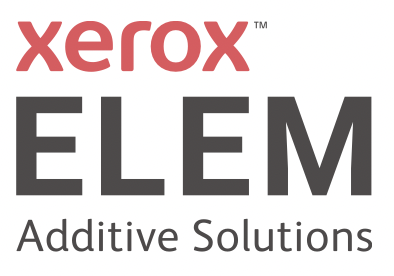
Tali Rosman, Vice President and General Manager of Xerox Elem Additive, will be giving the topic keynote for Session 1: Additive Manufacturing for Series Production of Metal Parts at Additive Manufacturing Strategies 2022, March 1-3. She will also be participating in Panel 2: Emerging applications for Metal Series Production.
Distributed Manufacturing can ease supply chain stress and eliminate bottlenecks by producing parts at the point of demand. This decentralized approach to manufacturing can have a profound effect on equipment downtime, inventory costs, and be a major contributor to reducing the carbon footprint. Manufacturers across the globe, specifically transportation and heavy equipment providers, are embracing this and searching for advanced technologies that are compatible with this direction.
Additive manufacturing (AM), specifically metal AM, is quickly evolving and becoming qualified for more than product development purposes. The reliability, part density, and material improvements enable metal AM to be a major tool for repairs, spares and low volume production needs. Can strategically distributed metal AM create a more resilient supply chain? I say yes and here are the four must-haves when it comes to implementing a truly distributed manufacturing approach with metal AM.
1. Location, Location, Location
In 2019, British Airways published an article focused on strategically placing printers at airports around the world to reduce delays for customers and emissions typically caused by transporting items. According to the article, 3D printing is an essential step towards the sustainable future of aviation, providing a path towards part light-weighting and eliminating the need to fly spare parts around the world with a decentralized manufacturing strategy.
Determining the location of these microfactories for point-of-demand manufacturing must be a strategic decision. It’s obvious for the aviation industry, but what about heavy equipment, energy, transportation or defense sectors? Adopting a pragmatic approach that combines customer density data, geographic utilization and future growth expectations will provide a clearer picture towards a successful distributed manufacturing strategy.
2. Easy, Dependable Metal AM
There are multiple metal additive technologies available within the industry. The focus of your application or purpose will determine which technology is right for you. Many current platforms can be quite complicated and require a certain amount of engineering expertise to maximize capabilities. This makes it challenging to teach multiple users, especially if they are located in various locations across the globe.

The goal is to have simple technologies that are attrition-proof and learnable by all levels of operators. If scalability is partly defined by accessibility, then we must also consider simplicity. At Xerox, we take this very seriously and have made ease-of-use a strategic focus with our Liquid Metal AM platform, ElemX.
3. Deployability
Deployability is defined by how feasible it is to adopt or apply a device in an actual implementation while ensuring that it is easy to arrange, place, or move strategically or appropriately. While many polymer printing technologies are relatively easy to install/de-install, that isn’t always the case with metal AM. Often, sophisticated systems require special facility accommodations and may raise challenges when it comes to material handling.
This is a key consideration to the future of distributed manufacturing. The ability to quickly install equipment at non-specialized or common machine shop facilities adds a significant advantage for OEMs and suppliers to strategically move printers on-demand to high-value locations. For example, military organizations across the globe are exploring metal AM for disaster relief scenarios and foreign base operations. Having metal AM that is deployable makes it easier to distribute.
4. Intelligent Software Tools
The final and maybe most important piece to the puzzle is having an integrated software platform that can connect and communicate across all locations, printers, users, etc. Access to a digital repository of 3D files with complete metadata makes it easier to assign jobs to specific printers within the distributed manufacturing network. These software tools must be technology agnostic and consider all the complexities that polymer and metal 3D printers possess. Finally, the ability to compare and contrast multiple technologies for cost and lead time is an invaluable data point that can help manufacturers make better-informed decisions for immediate part production.
Conclusion
Of course, there are many other factors to consider, and every OEM, government, or manufacturer must prioritize what is most important to their distributed manufacturing model. In my experience, equipment downtime is unacceptable, and customer satisfaction can never be overlooked, so part scheduling and immediacy is paramount. At Xerox, we are actively developing new hardware and software solutions that make it easier and safer to enable distributed manufacturing for anyone. We invite you to learn more about how we are tackling the next generation of innovation at www.xerox.com/3dprinting.
Subscribe to Our Email Newsletter
Stay up-to-date on all the latest news from the 3D printing industry and receive information and offers from third party vendors.
You May Also Like
3D Printing Unpeeled: New Arkema Material for HP, Saddle and Macro MEMS
A new Arkema material for MJF is said to reduce costs per part by up to 25% and have an 85% reusability ratio. HP 3D HR PA 12 S has been...
3D Printing News Briefs, January 20, 2024: FDM, LPBF, Underwater 3D Printer, Racing, & More
We’re starting off with a process certification in today’s 3D Printing News Briefs, and then moving on to research about solute trapping, laser powder bed fusion, and then moving on...
3D Printing Webinar and Event Roundup: December 3, 2023
We’ve got plenty of events and webinars coming up for you this week! Quickparts is having a Manufacturing Roadshow, America Makes is holding a Member Town Hall, Stratafest makes two...
Formnext 2023 Day Three: Slam Dunk
I’m high—high on trade show. I’ve met numerous new faces and reconnected with old friends, creating an absolutely wonderful atmosphere. The excitement is palpable over several emerging developments. The high...































